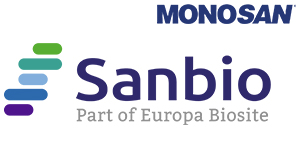Mouse anti-Vitronectin, clone BV1 (Monoclonal)
Mouse anti-Vitronectin, clone BV1 (Monoclonal)
Artikelnummer
SANMON3050
Verpackungseinheit
1 ml
Hersteller
Sanbio / Monosan
Verfügbarkeit:
wird geladen...
Preis wird geladen...
Clone Number: BV1
Immunogen: Unknown or proprietery to MONOSAN and/or its suppliers
Concentration: 100 ug/ ml
Storage buffer: PBS with 0.1% BSA and 0.02% sodium azide
Additional info: Monoclonal antibody BV1 recognizes human vitronectin. Vitronectin is an abundant glycoprotein (~75 kDa), consisting of 459 amino acids. About one third of the protein molecular mass is composed of carbohydrates. Vitronectin is found in blood plasma and the extracellular matrix. Vitronectin is a multifunctional protein, since it promotes attachment and spreading of animal cells in vitro, it inhibits cytolysis by the complement C5b-9 complex, and it modulates antithrombin III-thrombin action in blood coagulation. The protein consists of three domains: the N-terminal Somatomedin B domain (1-39), a central domain with hemopexin homology (131-342) and a C-terminal domain (347-459) also with hemopexin homology. The Somatomedin B domain binds to Plasminogen Activator Inhibitor-1 (PAI-1) and is responsible for PAI-1 stabilization. Furthermore, the Somatomedin B domain can also interact with the urokinase plasminogen activator receptor (uPAR). Vitronectin-uPAR interaction is required and sufficient to initiate downstream changes in cell morphology, migration and signal transduction. High plasma levels of both PAI-1 and uPAR have been shown to correlate with a negative prognosis for cancer patients. Additionally, vitronectin is a component of platelets and is as such involved in hemostasis. Amino acid 45-47 (RGD) are capable of binding to membrane bound integrins, which serve to anchor cells to the extracellular matrix. Vitronectin in plasma is an inactive monomer form. In contrast, tissue vitronectin is an active multimeric form and is able to interact with various matrix ligands like proteoglycans and collagen. Mice with a genetic deletion of vitronectin show delayed wound healing, suggesting an important role of vitronectin in tissue remodeling after injury. The monoclonal antibody BV1 binds to soluble vitronectin as well as to membrane bound vitronectin.
References: Martin-Padura; I et al. J path 1995; 175: 51 /Zanetti, A et al Blood 1994, 84: 1116
Immunogen: Unknown or proprietery to MONOSAN and/or its suppliers
Concentration: 100 ug/ ml
Storage buffer: PBS with 0.1% BSA and 0.02% sodium azide
Additional info: Monoclonal antibody BV1 recognizes human vitronectin. Vitronectin is an abundant glycoprotein (~75 kDa), consisting of 459 amino acids. About one third of the protein molecular mass is composed of carbohydrates. Vitronectin is found in blood plasma and the extracellular matrix. Vitronectin is a multifunctional protein, since it promotes attachment and spreading of animal cells in vitro, it inhibits cytolysis by the complement C5b-9 complex, and it modulates antithrombin III-thrombin action in blood coagulation. The protein consists of three domains: the N-terminal Somatomedin B domain (1-39), a central domain with hemopexin homology (131-342) and a C-terminal domain (347-459) also with hemopexin homology. The Somatomedin B domain binds to Plasminogen Activator Inhibitor-1 (PAI-1) and is responsible for PAI-1 stabilization. Furthermore, the Somatomedin B domain can also interact with the urokinase plasminogen activator receptor (uPAR). Vitronectin-uPAR interaction is required and sufficient to initiate downstream changes in cell morphology, migration and signal transduction. High plasma levels of both PAI-1 and uPAR have been shown to correlate with a negative prognosis for cancer patients. Additionally, vitronectin is a component of platelets and is as such involved in hemostasis. Amino acid 45-47 (RGD) are capable of binding to membrane bound integrins, which serve to anchor cells to the extracellular matrix. Vitronectin in plasma is an inactive monomer form. In contrast, tissue vitronectin is an active multimeric form and is able to interact with various matrix ligands like proteoglycans and collagen. Mice with a genetic deletion of vitronectin show delayed wound healing, suggesting an important role of vitronectin in tissue remodeling after injury. The monoclonal antibody BV1 binds to soluble vitronectin as well as to membrane bound vitronectin.
References: Martin-Padura; I et al. J path 1995; 175: 51 /Zanetti, A et al Blood 1994, 84: 1116
| Artikelnummer | SANMON3050 |
|---|---|
| Hersteller | Sanbio / Monosan |
| Hersteller Artikelnummer | MON3050 |
| Green Labware | Nein |
| Verpackungseinheit | 1 ml |
| Mengeneinheit | STK |
| Reaktivität | Human |
| Klonalität | Monoclonal |
| Methode | Immunofluorescence, Immunoprecipitation, Western Blotting, ELISA, Flow Cytometry |
| Isotyp | IgG1 |
| Wirt | Mouse |
| Produktinformation (PDF) | Download |
| MSDS (PDF) |
|

 English
English







